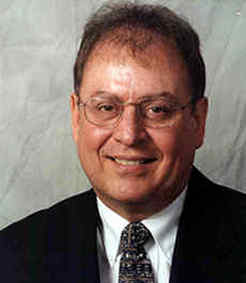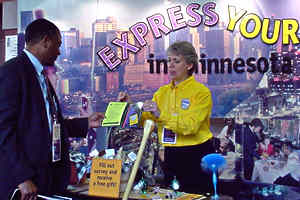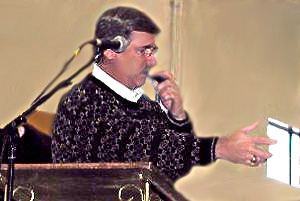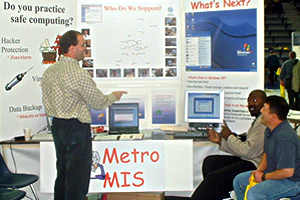 |
 |
|
 |
Weiszhaar outlines priorities for next few months |
 |
 |
 |
Acting Commissioner Doug Weiszhaar
|
Earlier this month, Gov. Jesse Ventura appointed Doug Weiszhaar as Mn/DOTís
acting commissioner to succeed former Commissioner Elwyn Tinklenberg, whose
last day was Oct. 4.
Youíve been an integral part of Mn/DOT for more than three years. What do
you see as the departmentís most significant accomplishments during that time?
DW: Clearly, the Moving Minnesota initiative is up there. The one-time
legislative funding of $459 million in 2000 allowed us to accelerate projects
by a total of 113 years and save about $65 million in inflation costs. None
of the success with Moving Minnesota would be possible if we had not improved
some of our processes. More importantly, we couldnít have done it without our
employees, many of whom have gone into overdrive to make it happen.
The streamlining initiative is another significant accomplishment that helps
us to deliver projects and speed up our construction processes. It encompasses
a number of practices, such as design-build, which involves designing and building
a project in overlapping stages to save time and money. Electronic bidding saves
the state an estimated $1,000 per letting and footprinting allows land to be
purchased based on estimated right-of-way needs rather than traditional site
surveying. These initiatives are shaving many months off typical project
delivery timelines.
Itís difficult to name all of Mn/DOT's accomplishments, but others include
the Hiawatha light rail transit system in Minneapolis, which is now more than
halfway done, and intelligent transportation technologies such as the special
vehicle that increases safety for snow plow drivers, ambulance drivers and others
who must drive in bad weather to provide services to the public
Whatís the biggest disappointment youíve experienced during your tenure
here?
DW: Iíd say it was the Legislatureís failure to provide a long-term
permanent funding source for transportation. Its inaction, plus the poor economic
climate of the last year or so, led to our announcement in June that we will
likely need to defer or drop 163 projects that were scheduled to begin during
the next 10 years. And, although we have streamlined agency operations, improved
efficiency alone cannot pay for the increased demand on the transportation system,
nor can it make up for 15 years of inadequate funding.
What are your top priorities for the next few months?
DW: My plan is to continue the course we have set forth for Moving
Minnesota, and to ensure a smooth changeover from this administration to the
next. I want the next administration to have the information it needs to make
solid decisions as well as build upon what weíve already done. We have a transition
team right now working on just that.
Do you plan to continue with the Shaping Our Future effort?
DW: Absolutely. Shaping Our Future is not a short-term initiative with
a beginning and end point. It is a new way of doing business. We are constantly
looking for ways to better meet the needs of our customers. In fact, we are
ahead of a national trend of transportation agencies that are beginning to use
some of these approaches to speed up project delivery.
Although a lot of the Shaping Our Future attention to date has been focused
on the products and services we deliver and the movement of staff and resources
to best meet our customersí needs, the change management initiatives are just
the beginning of a continuous process. There are many other activities going
on that contribute to shaping Mn/DOTís future.
Such as?
DW: Streamlining program delivery, which weíve already talked a bit
about here. Also, weíve consolidated the shared business services functions
in the Capitol complex and modal offices to achieve greater efficiency processing
transactions. Weíre also coordinating training and weíre developing the biennial
budget.
In addition, weíre looking at staffing to ensure that we have the right people
with the right skills in the right place. This is especially important since
two-thirds of our engineering and technical workforce is eligible to retire
within five years. We must prepare now.
About the budgetówhatís going on with the additional 10 percent budget cuts
agencies were told to make? Are people in danger of being laid off?
DW: In August, the Department of Finance told all state agencies to
make recommendations on how to cut their budgets by 10 percent. This was on
top of the cuts we were asked to do several months ago. Our budget recommendations
were completed Oct. 15.
Unlike before, it looks like we wonít be able to absorb the losses through
retirements or leaving vacancies open. We may need to defer additional projects
in the construction program or, in the worst-case scenario, lay off some employees.
Our goal still is to retain a skilled workforce, but the economic reality is
we may need to cut back on staff. We wonít know what our course of action will
be until we have further direction from the Department of Finance. In the meantime,
we will continue to show them what weíve already done.
Besides the obvious budget difficulties, what do you see as the toughest
challenge for the next administration?
DW: Just as we did, the next administration is going to have to tackle
transportation financing. It doesnít matter if youíre a proponent of the "more
roads" or the "more transit options" approach. If no long-term
permanent funding source for transportation is established soon, we will have
a difficult time preserving and maintaining what we have and all of the other
issues will be moot.
Note: On Oct. 15, Weiszhaar sent a memo to Gov. Venturaís staff to
help them brief the incoming administration about four key transportation-related
issues and Mn/DOTís recommendations for addressing them. Click here to read
the memo to
the governor-elect.
By Chris Joyce
|
back

|
 |
Ban on Trunk Highway Fund payment for state sales tax causes purchasing freeze |
 |
 |
Because legislative action prohibits Trunk Highway Fund monies from being used
to pay the state sales tax, Mn/DOT has placed a freeze on purchases where it
applies.
The 2001 Legislature appropriated $4.3 million from the General Fund to reimburse
Mn/DOT for sales tax payments in FY 2002. Those funds, however, have been spent
and there is no similar General Fund appropriation for FY 2003.
If Mn/DOT continued purchasing but didnít pay sales tax, the department would
be violating state law. However, if Mn/DOT does pay the sales tax, it would
violate a different state law.
Mn/DOT has instructed managers to halt purchases that include sales tax until
Mn/DOT, Department of Finance and the Governorís Office can resolve the issue.
Staff members believe the freeze should not be in effect longer than from five
to seven days.
Items for emergency situations where public safety is a factorósuch as road
repairóare not affected by the purchasing freeze.
Dick Stehr, director, Program Support Group, said, however, that purchases
for program activities such as fuel, right of way purchases and contractorsí
payments arenít affected because theyíre not subject to the stateís sales tax.
The freeze also doesnít apply to purchases made from specific funds such as
the State Airports Fund, the Greater Minnesota Transit Fund or state transportation
bonds used for local bridge construction.
Typically Mn/DOT spends about $5 million each year in state sales tax. Purchases
include computers, furniture, asphalt, aggregate, patching materials and janitorial
supplies.
Bruce Briese, director, Financial Planning Analysis, said the problem stems
from conflicting state laws. One law, he said, requires that state agencies
pay state sales tax. However, another specifically prohibits expenditures from
the Trunk Highway Fund for any purpose other than highway maintenance and construction.
This includes sales tax payments.
Briese said negotiations are underway by representatives from Mn/DOT, the Department
of Finance and the Governorís Office to resolve the situation quickly.
The Legislature will have to address the issue during its next session to eliminate
the conflict in the laws, he said.
Questions about the purchasing and payments may be addressed to Jim Kinzie,
651/297-2510, or Roy Kill, 651/215-1983. Questions about funding sourcesí taxable
status may be addressed to Gordy Kordosky, 651/296-3225, or Larry Schmitz, 651/296-7090.
All four are in Financial Management.
By Craig Wilkins
|
back

|
 |
North to Alaska: Mn/DOT staff members warm up to host AASHTO in 2003 |
 |
 |
 |
FHWA official James Cheatham receives a survey from Barb Connolly,
human resources manager, Business Services Section, at Mn/DOTís booth
at AASHTOís annual meeting in Anchorage. Photo by Sandy East
|
More than 1,300 delegates attended the 88th annual meeting of the American
Association of State Highway and Transportation Officials in Anchorage Oct.
11-15. Delegates represented all 50 states plus the District of Columbia and
Puerto Rico.
Mn/DOT representatives included managers, engineers, communications staff,
conference planners and support staff. Minnesota will host the national AASHTO
conference in September 2003.
AASHTO, a nonprofit, nonpartisan association founded in 1914, represents five
transportation modes: air, highways, public transportation, rail and water.
AASHTO's primary goal is to foster the development, operation and maintenance
of an integrated national transportation system.
Weiszhaar said that the contacts with other states benefit Minnesota in delivering
quality service to its customers. Mn/DOT has been exchanging knowledge, research
and best practices with AASHTO members since the Minnesota state highway system
was established in 1922.
Emil Frankel, U.S. DOT assistant secretary for policy, opened the session by
stating that both the events of 9/11 and reduced revenues will complicate the
process of reauthorization of the federal transportation bill by Congress. At
the conference, AASHTO presented a variety of funding alternatives and financing
tools to help meet the financial crisis.
Mn/DOT will host the next AASHTO annual meeting Sept. 4-9, 2003, at the Minneapolis
Convention Center. Mn/DOT staff surveyed conference participants about their
interests when they come to the Twin Cities at the Mn/DOT "Express yourself!"
exhibit and encouraged them to visit and experience Minnesota.
"It's important for Minnesota to advocate our needs at a national level," said
acting Commissioner Doug Weiszhaar. "Congress is again considering a federal
transportation bill that will guide our programs for the next six years."
There is another benefit to hosting the meeting: participants will spend an
estimated $2 million in Minnesota during the week-long conference.
By Sue Stein
|
back

|
 |
Succession planning, strategic staffing hold keys to the future |
 |
 |
How do you prepare to become a leader at Mn/DOT? How do you gain the technical
and/or managerial skills to fill positions Mn/DOT will need most in the future?
"With the help of two tools designed to develop employees with leadership
potential, we will be able to get the right people in the right job at the right
time," said Wayne Brede, Human Resources staffing manager.
Those tools are succession planning and strategic staffing.
"The challenge to government in this decade will be to find ways to attract,
train and retain qualified workers within a shrinking, aging labor market,"
said Doug Weiszhaar, acting commissioner. "Succession planning and strategic
staffing will help employees find work situations that are the best fit for
the department and allow them to grow and achieve in a changing environment."
"Succession planning identifies critical leadership roles that need to
be filled in a timely manner through internal development or through external
recruitment when internal development is not practical or timely," said
Brede.
Succession planning begins by determining if critical positions can be filled
with the employees available. If not, managers look for succession planning
candidates with the aptitudes, interests and decision-making abilities leaders
possess. But leaders donít become leaders overnight. Candidates must be developed
for key leadership positions. Their competencies must be assessed and training
plans developed to help them gain leadership skills.
These qualities and skills can be gained through Mn/DOTís mentoring program
which matches experienced employees with other employees interested in receiving
career guidance. The Leadership Academy training will also help provide leaders
with additional skills. It will begin in 2002 with management and supervisory
level candidates but eventually will expand to include employees at all levels
of the organization.
"Mn/DOT is committed to becoming the kind of organization that values
the contribution of all its employees--of all backgrounds, all interests and
all cultures." Weiszhaar added.
Currently, 37 positions have been identified as part of the succession planning
process, but Mn/DOT will need more leaders in the future. All managers are eligible
to participate in succession planning and, since the program started in 1994,
their participation has been voluntary. However, the Senior Management Team
recently directed that all managers must participate in succession planning
as candidates or as coaches or mentors to other participants.
"The idea that Mn/DOT has predetermined who is going to be selected for
succession planning is far from the truth," Brede added. "Managers
must keep their eyes open for employees with good leadership aptitude. But itís
also up to employees to express their interest in leadership opportunities and
do what it takes to be recognized."
"Succession planning is not the only way we develop leaders," Weiszhaar
added. "Because Mn/DOT could lose 65 percent of its technical and professional
workforce to retirement and attrition by the year 2007, we must find ways to
help employees at all levels make the best use of their skills."
Succession planning focuses on executive-level staffing needs, whereas strategic
staffing applies to all employees. It helps determine where employees need job
development, including mentoring and formal training, to reach their full potential.
Strategic staffing can, however, help identify employees who are ideal candidates
for succession planning.
"The concept of strategic staffing is relatively new to Mn/DOT,"
said Trent Weber, HR strategic staffing coordinator. "It was first introduced
as a pilot effort in 1999 in Willmar/District 8 and was expanded to the Program
Delivery Group in August 2001. The plan is to include the entire department
in the formal strategic staffing process within the next six months."
One key supporter is Sue Mulvihill, Metro Division area maintenance engineer.
"My leadership interests and abilities were recognized at Mn/DOT, she said.
"My supervisors, co-workers and mentors worked with me to help me develop
those skills and to advance. Iíve learned a lot from all the people Iíve worked
with, which has helped me become a better leader. My experience shows that there
are opportunities for women and other underrepresented groups at Mn/DOT if you
work hard, take on new challenges and make the changes necessary to advance."
"Making Mn/DOT and our transportation system work better is not about
the products and services we create itíabout the people who create them,"
Weiszhaar said.
For more information, contact Brede or Weber via GroupWise.
By Donna Lindberg
|
back

|
 |
New Pike Lake facility supports shared operations in Duluth area |
 |
 |
 |
Mike Robinson, Duluth/District 1 engineer, welcomes visitors to the
new Pike Lake maintenance facility shared by Mn/DOT and St. Louis County
maintenance forces. Photo by Maureen Talarico
|
The trend toward consolidated state, county and city maintenance facilities
continues with the opening of the new facility on Hwy 53 about 10 miles northwest
of Duluth that serves Mn/DOTís Duluth metro crews and St. Louis Countyís maintenance
operations.
The new building is the most recent combined facility built by Mn/DOT and local
government agencies. The first, at Hutchinson, was completed in 1997 to serve
Willmar/District 8, McLeod County and the city of Hutchinson.
Dedication ceremonies for the new $5.5 million Pike Lake facility were held
Tuesday by officials from each agency as well as from Canosia Township where
itís located.
Mn/DOTís share of the total cost is $1.6 million. The project required no Mn/DOT
cash cost. Mn/DOTís share of the county-financed bond issue will be covered
by payments from the city of Duluth for leasing space in the district headquarters
maintenance shop.
The consolidation allows the county to close two truck stations in residential
areas and affords Mn/DOT crews easier and faster access to Hwy 53 and the other
highways it maintains in the Duluth area. Moving nine snowplows from the Duluth
headquarters building provides a central location for part of the cityís snowplow
fleet.
The new facility includes amenities such as an automated truck wash and adequate
storage as well as maintenance and administrative areas for Mn/DOT and county
crews and equipment. Sharing the facility also reduces costs via the joint purchase
and storage of the sand, gravel, and de-chemicals that each agency uses for
its work.
Crews from St. Louis County and Mn/DOT did the grading work for the new facility,
which underscores the cooperative atmosphere the new building represents.
By Craig Wilkins |
back

|
 |
Winter work safety blitz to alert drivers statewide |
 |
 |
 |
This billboard reminds drivers to "Stay Back Stay Alive."
Design by Roberta Link
|
Football fans heading into the Metrodome on Nov. 9 to see the University of
Minnesota take on the University of Michiganís Wolverines will get a bonusóa
blitz of winter work zone safety messages. Mn/DOT employees will staff display
a tandem-axle snowplow on the plaza and staff an informational exhibit inside
the Dome.
The "Stay Back Stay Alive" message will be repeated at the game and
many times during the month of November with alerts to Minnesotans urging them
to use extra caution when snowplows are operating.
Nov. 4 marks the start of National Winter Safety Awareness Week. During that
week, several state agencies including Mn/DOT will use various means to urge
the public to focus on winter safety. Nov. 8 will focus on winter driving safety.
On Nov. 12, Mn/DOT will invite news reporters to visit the Metro Divisionís
annual snow and ice kick-off event, which is an opportunity to learn about snowplowing
techniques, plowing equipment and safety priorities. Mn/DOT will encourage reporters
to ride with a plow operator to become familiar with plowing operations and
the need for safer driving behavior by motorists.
Mary Meinert, work zone safety coordinator, Communications and Public Relations,
said the winter campaign would use radio ads, bus advertising, theater adverting
and attendance at conferences and expos to convey its message about winter safety.
"Safety is Mn/DOTís first priority, " she said. "This year we
are planning to extend a special effort to reach the Latino, Hmong and Somali
communities to share our safe winter driving information."
Meinert said that there is an average of 110 crashes involving snowplows every
year in Minnesota. She added that the number of people who get hurt in these
crashes averages 10 per year.
"We need to constantly repeat our message--Stay Back Stay Alive--in order
to protect our snowplow operators and everyone else using the stateís roads,"
she said.
Tickets to the game, which cost $11 and include a hot dog and soft drink, can
be ordered by calling 612/624-7342.
By Craig Wilkins
|
back

|
 |
Employee Days showcases Metro Division |
 |
 |
 |
From left: Jim Cray, Metro MIS, discusses computer security issues
with Garland Jackson, Metro MIS, and Moses Her, Design. Photo by
Kent Barnard
|
Employees from throughout the Metro Division gathered Oct.16-17 at Aldrich
Arena in Maplewood for the annual Metro Employee Days.
Set up outside the arena was a truck with cones, barrier and all signing needed
to establish a safe work zone. A new type of truck-mounted attenuator (crash
cushion) on the back of the vehicle rounded out the truckís safety features.
Inside the building, exhibits on health and safety-related topics drew attention
from participants. Employees could also get more information on health and dental
plans that are available during Octoberís open enrollment period.
Functional area exhibits highlighted the ways in which various offices work
together in Metro to carry out its responsibilities.
Participants could also vote on their favorite functional area booths. First
place honors went to the Office of Maintenance booth. Design employees captured
second place while the Human Resources booth finished third.
By Kent Barnard
|
back

|
 |
|
 |



